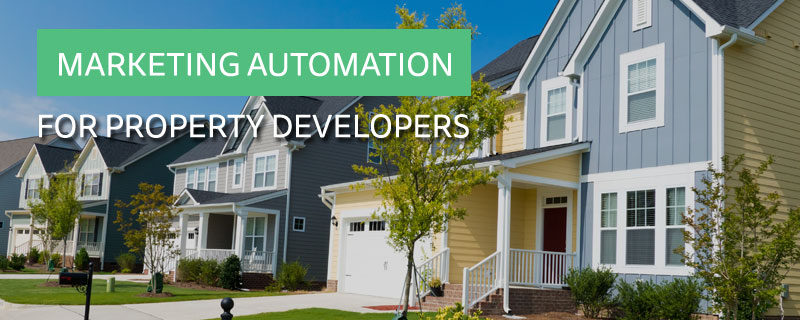BLOG
Guide to Marketing Automation for Property
Any property developer will tell you that the best way to keep new leads coming in and customers coming back for more is to invest in marketing automation software. You’re probably heard of this type of software, but you might not know much about it – or how useful it can truly be.
Marketing automation software is a type of program that schedules and automates repetitive tasks that you or your marketing team might forget. This automation allows marketers to narrow down certain criteria and outcomes for processes and tasks to create tailored ads that will reach the client at their peak moments of interests. This information from these ads is then translated into analytics and stored.
So how can a property developer effectively use this technology to generate good leads? Here is the ultimate property developer’s guide to marketing automation. Read on to learn how you can get started.
Gather/Clean your databases
Now is the time to be completely honest with yourself. You’ve chosen marketing automation because you want to see real results, right? You want leads to grow into purchases and to nurture relationships with your customers, right? Then it is time to get tough.
Open your database and start going through all of your contacts and customers. You need to evaluate what type of customer each one is. Have you worked with this person before? For how long? Did he or she purchasing anything from you? Were they a pleasure to work with?
Take out owner occupiers you can safely assume are no longer in need of your services (hopefully because you’ve already helped them). If a homeowner finds him or herself looking for a new home and you already had a great experience together, there’s a good chance the homeowner will come back to you without provocation. Property developers are like auto mechanics: once you find one you know you can trust, you won’t let anyone else handle your needs.

Separate investors from owner occupiers (as much as possible)
As a property developer, you know there are mainly two types of buyers: those that invest and those looking for a home. Both are equally valuable customers with vastly different needs, and it is up to you to analyse these needs and decide how to meet them.
Investors are looking to buy up property at a good price and then sell the property when the housing market is doing well. Though we said there are mainly two types of buyers, there are so many subgroups of investment buyers. Take a look:
- Residential renter: These buyers focus on location first. In order to get renters, the house must be near good schools to attract a family or close to a university to entice students. From there, the investors might have different needs, but you need to start with locations.
- Commercial renter: This buyer is looking for commercial buildings with great locations, plenty of space and easy accessibility.
- House flipper: When you see a worn-down home in a good neighbourhood, then you probably think of a few clients who might be interested.
Residential buys are looking for a place to call their own. They more than likely have a laundry list of needs, some you can predict and other you cannot. You can always target owner occupiers with desirably home features, such as:
- An open-concept kitchen
- Multiple bedrooms and bathrooms
- A pool, hot tub, play house or other cool feature
- Location
For some of these clients, the line between investor and owner occupier may blur, but you can always include them on similar lists.
Identify common objections for each
Now it’s time to go back to your groups and really look at what each group needs and wants from its property developer.
Once you have a general idea of what your client wants to buy, start thinking about which designs and copy will attract them. Here is where you can further break down investor and owner occupier needs. Narrow down the types of investors and potential homeowners, such as families, retired couples, young couples and singles. Now create ads that promote what those groups want. Here are a few ideas:
- Family: Showcase homes in great school districts or with a pool
- Commercial investor: Give them the lowdown on the newest, up-and-coming development
- Retired couple: Promote homes that are smaller and easier to manage, and are in warm, quiet spots
- Residential renter: Highlight homes for university students, families, whatever it is that your investors are looking to rent out

Create a customer journey through well crafted email
Your marketing automation should lead customers effortlessly through a carefully constructed narrative that first grabs their attention, appeals to their needs and wants and finally shows them exactly what they were looking for.
Copy and design go hand in hand, and one should not overpower the other. Your call-to-action (what you want your subscribers to do) should be obvious and plainly stated to avoid any confusion. The copy should be concise and tight. Do not try to fill up the page with miscellaneous text. As we said, owner occupiers are looking for forever homes, so your text should be welcoming and engaging. For investors, you need to show them what features of a certain home will attract high-paying renters (granite benchtops, stainless steel appliances).
Once your client gets to the landing page deliver exactly what was promised and keep the navigation simple. If you advertised beachfront homes, your landing page had better have beachfront homes. The next step in your call-to-action should be front and centre. If you want clients to sign up for blog updates, make sure they know where to add their email addresses.
Track and score your hottest prospects
Of course, none of this work is worth much is you do not track and compare your results. One of the biggest benefits of using automated marketing is that it gives you almost instant data to compare. From there you can determine:
- How many people opened your email
- How many clicked on the email
- How many completed your call to action
Go through your data and decipher what is and isn’t working. Owner occupiers with families may have clicked on the email about homes in good school districts, but something made them decide not to click to your website. What could it be? Maybe your call-to-action wasn’t clear enough. If at first you don’t succeed, definitely try again.
Marketing automation is all about creating individual experiences for your clients in a smooth and effortless manner. It allows you to schedule your marketing so it hits your clients’ inboxes at their peak time, ensuring your emails won’t be lost in the other messages. Grow more leads and keep customers returning for the second, third and even retirement property.











